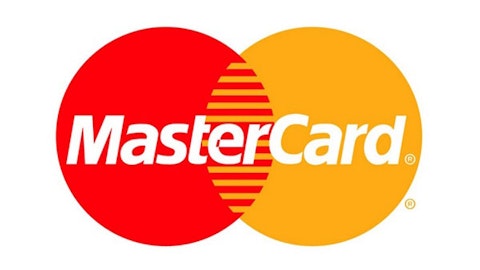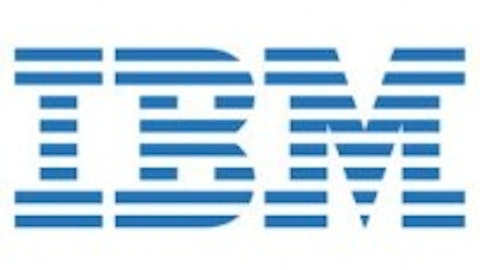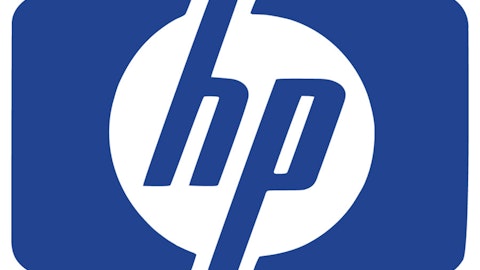Less than a year ago, shares of tech giant Hewlett-Packard Company (NYSE:HPQ) were in the gutter. After being valued at over $120 billion in 2010, the market left HP for dead, dragging its market capitalization down substantially. The hiring of new CEO Meg Whitman, former CEO of eBay, in late 2011 did little to stop the decline, with the stock hitting a low a little over a year later.
Since that low, the stock has rebounded strongly, more than doubling before disappointing earnings and guidance caused a steep sell-off in late August. With the company still valued well below its peak, does HP offer value for investors? Or is the company set for a slow, painful decline?

Included in Hewlett-Packard Company (NYSE:HPQ)’s recent earnings presentation was the record of revenue growth over the past three years:

Of course, what matters for investors is the next three years and beyond, and for that we need to know where Hewlett-Packard Company (NYSE:HPQ) makes its money.
Hewlett-Packard Company (NYSE:HPQ) is split into five groups, and as you can see from the following table, nearly all of them are shrinking:
HP groups
| $in millions | Q3 Net Revenue | Growth y/y% | Non-GAAP OP $ | Non-GAAP OP % of rev |
|---|---|---|---|---|
| Printing | $5,803 | -4% | $908 | 15.6% |
| Personal Systems | $7,704 | -11% | $228 | 3% |
| Printing & Personal Systems Group | $13,507 | -8% | $1,136 | 8.4% |
| Enterprise Group | $6,786 | -9% | $1,033 | 15.2% |
| Enterprise Services | $5,843 | -9% | $192 | 3.3% |
| Software | $982 | 1% | $201 | 20.5% |
| HP Financial Services | $879 | -6% | $99 | 11.3% |
| Total HP | $27,226 | -8% | $2,296 | 8.4% |
The first group, printing and personal systems, is the largest contributor to earnings and makes up about half of the total revenue. Although it would seem like the printing division, which includes both printing hardware and supplies, should be in a total free-fall, unit sales were actually up in the third quarter. Commercial hardware units rose by 12% year over year, with consumer units jumping by 2%. Revenue from supplies was down, leading to the overall decline, since supplies make up two-thirds of the total printing revenue, but the picture is not as grim as I had expected.
About 40% of the total non-GAAP operating income came from printing, and the stability of the printing operating margin is encouraging. The operating margin has remained around 15-16% for the past few years, with minimal fluctuations. One thing benefiting Hewlett-Packard Company (NYSE:HPQ) is that there is an implicit barrier to entry into the printing business. No company in its right mind would try to compete with the big players in a permanently declining industry, giving HP and its current competitors the ability to extract high-margin profits. Although printing revenue will likely continue to decline, profits from the business shouldn’t fall much faster than revenue.
The other part of the group, personal systems, includes desktops, laptops, and workstations. This business has terrible profit margins and is stuck in decline as the PC market contracts. HP should have gotten out of the PC market years ago, much like International Business Machines Corp. (NYSE:IBM) did.
The enterprise group includes servers, storage, and networking. This division is responsible for 45% of the total operating profit, making the declining revenue and margin concerning. Operating margin has fallen from around 20% at the end of 2011 to 15% today, and the trend shows no sign of reversing any time soon. A big shift is occurring in the server market, with companies and organizations increasingly outsourcing their computing to the cloud. Proprietary servers are becoming decreasingly relevant, and HP’s most profitable division will likely suffer in the coming years. Profits derived from servers are going to dry up far faster than profits derived from printing.
This shift to the cloud also threatens International Business Machines Corp. (NYSE:IBM), which dodged one bullet by selling its PC business to Lenovo in 2004. Earlier this year, IBM was in talks to sell part of its server business to Lenovo as well, but those talks broke down. Servers are increasingly becoming a commodity, and weak hardware sales led to disappointing earnings for IBM earlier this year.




